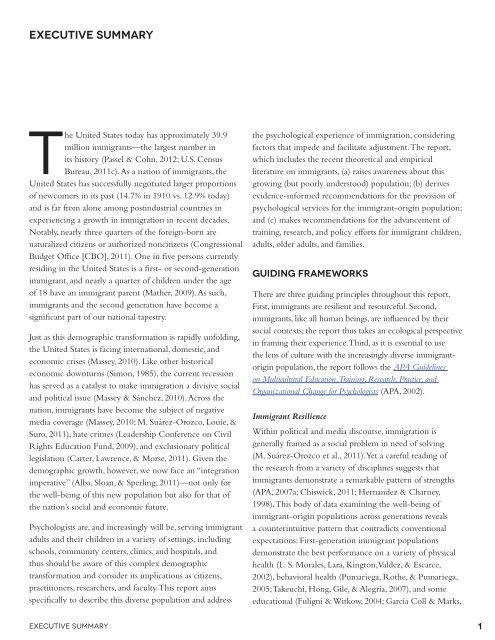Crossroads: The Psychology of Immigration in the New Century
Crossroads: The Psychology of Immigration in the New Century
Crossroads: The Psychology of Immigration in the New Century
Create successful ePaper yourself
Turn your PDF publications into a flip-book with our unique Google optimized e-Paper software.
Executive summary<br />
<strong>The</strong> United States today has approximately 39.9<br />
million immigrants—<strong>the</strong> largest number <strong>in</strong><br />
its history (Passel & Cohn, 2012; U.S. Census<br />
Bureau, 2011c). As a nation <strong>of</strong> immigrants, <strong>the</strong><br />
United States has successfully negotiated larger proportions<br />
<strong>of</strong> newcomers <strong>in</strong> its past (14.7% <strong>in</strong> 1910 vs. 12.9% today)<br />
and is far from alone among post<strong>in</strong>dustrial countries <strong>in</strong><br />
experienc<strong>in</strong>g a growth <strong>in</strong> immigration <strong>in</strong> recent decades.<br />
Notably, nearly three quarters <strong>of</strong> <strong>the</strong> foreign-born are<br />
naturalized citizens or authorized noncitizens (Congressional<br />
Budget Office [CBO], 2011). One <strong>in</strong> five persons currently<br />
resid<strong>in</strong>g <strong>in</strong> <strong>the</strong> United States is a first- or second-generation<br />
immigrant, and nearly a quarter <strong>of</strong> children under <strong>the</strong> age<br />
<strong>of</strong> 18 have an immigrant parent (Ma<strong>the</strong>r, 2009). As such,<br />
immigrants and <strong>the</strong> second generation have become a<br />
significant part <strong>of</strong> our national tapestry.<br />
Just as this demographic transformation is rapidly unfold<strong>in</strong>g,<br />
<strong>the</strong> United States is fac<strong>in</strong>g <strong>in</strong>ternational, domestic, and<br />
economic crises (Massey, 2010). Like o<strong>the</strong>r historical<br />
economic downturns (Simon, 1985), <strong>the</strong> current recession<br />
has served as a catalyst to make immigration a divisive social<br />
and political issue (Massey & Sánchez, 2010). Across <strong>the</strong><br />
nation, immigrants have become <strong>the</strong> subject <strong>of</strong> negative<br />
media coverage (Massey, 2010; M. Suárez-Orozco, Louie, &<br />
Suro, 2011), hate crimes (Leadership Conference on Civil<br />
Rights Education Fund, 2009), and exclusionary political<br />
legislation (Carter, Lawrence, & Morse, 2011). Given <strong>the</strong><br />
demographic growth, however, we now face an “<strong>in</strong>tegration<br />
imperative” (Alba, Sloan, & Sperl<strong>in</strong>g, 2011)—not only for<br />
<strong>the</strong> well-be<strong>in</strong>g <strong>of</strong> this new population but also for that <strong>of</strong><br />
<strong>the</strong> nation’s social and economic future.<br />
Psychologists are, and <strong>in</strong>creas<strong>in</strong>gly will be, serv<strong>in</strong>g immigrant<br />
adults and <strong>the</strong>ir children <strong>in</strong> a variety <strong>of</strong> sett<strong>in</strong>gs, <strong>in</strong>clud<strong>in</strong>g<br />
schools, community centers, cl<strong>in</strong>ics, and hospitals, and<br />
thus should be aware <strong>of</strong> this complex demographic<br />
transformation and consider its implications as citizens,<br />
practitioners, researchers, and faculty. This report aims<br />
specifically to describe this diverse population and address<br />
EXECUTIVE SUMMARY<br />
<strong>the</strong> psychological experience <strong>of</strong> immigration, consider<strong>in</strong>g<br />
factors that impede and facilitate adjustment. <strong>The</strong> report,<br />
which <strong>in</strong>cludes <strong>the</strong> recent <strong>the</strong>oretical and empirical<br />
literature on immigrants, (a) raises awareness about this<br />
grow<strong>in</strong>g (but poorly understood) population; (b) derives<br />
evidence-<strong>in</strong>formed recommendations for <strong>the</strong> provision <strong>of</strong><br />
psychological services for <strong>the</strong> immigrant-orig<strong>in</strong> population;<br />
and (c) makes recommendations for <strong>the</strong> advancement <strong>of</strong><br />
tra<strong>in</strong><strong>in</strong>g, research, and policy efforts for immigrant children,<br />
adults, older adults, and families.<br />
Guid<strong>in</strong>g Frameworks<br />
<strong>The</strong>re are three guid<strong>in</strong>g pr<strong>in</strong>ciples throughout this report.<br />
First, immigrants are resilient and resourceful. Second,<br />
immigrants, like all human be<strong>in</strong>gs, are <strong>in</strong>fluenced by <strong>the</strong>ir<br />
social contexts; <strong>the</strong> report thus takes an ecological perspective<br />
<strong>in</strong> fram<strong>in</strong>g <strong>the</strong>ir experience. Third, as it is essential to use<br />
<strong>the</strong> lens <strong>of</strong> culture with <strong>the</strong> <strong>in</strong>creas<strong>in</strong>gly diverse immigrantorig<strong>in</strong><br />
population, <strong>the</strong> report follows <strong>the</strong> APA Guidel<strong>in</strong>es<br />
on Multicultural Education, Tra<strong>in</strong><strong>in</strong>g, Research, Practice, and<br />
Organizational Change for Psychologists (APA, 2002).<br />
Immigrant Resilience<br />
With<strong>in</strong> political and media discourse, immigration is<br />
generally framed as a social problem <strong>in</strong> need <strong>of</strong> solv<strong>in</strong>g<br />
(M. Suárez-Orozco et al., 2011). Yet a careful read<strong>in</strong>g <strong>of</strong><br />
<strong>the</strong> research from a variety <strong>of</strong> discipl<strong>in</strong>es suggests that<br />
immigrants demonstrate a remarkable pattern <strong>of</strong> strengths<br />
(APA, 2007a; Chiswick, 2011; Hernandez & Charney,<br />
1998). This body <strong>of</strong> data exam<strong>in</strong><strong>in</strong>g <strong>the</strong> well-be<strong>in</strong>g <strong>of</strong><br />
immigrant-orig<strong>in</strong> populations across generations reveals<br />
a counter<strong>in</strong>tuitive pattern that contradicts conventional<br />
expectations: First-generation immigrant populations<br />
demonstrate <strong>the</strong> best performance on a variety <strong>of</strong> physical<br />
health (L. S. Morales, Lara, K<strong>in</strong>gton, Valdez, & Escarce,<br />
2002), behavioral health (Pumariega, Ro<strong>the</strong>, & Pumariega,<br />
2005; Takeuchi, Hong, Gile, & Alegría, 2007), and some<br />
educational (Fuligni & Witkow, 2004; García Coll & Marks,<br />
1
















